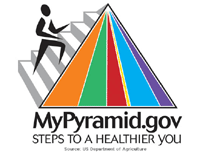Diet and Cardiovascular Disease
The food guide pyramid is a guideline to help you eat a healthy diet. The food guide pyramid can help you eat a variety of foods while encouraging the right amount of calories and fat. The United States Department of Agriculture (USDA) and the US Department of Health and Human Services have prepared the following food pyramid to guide you in selecting foods.
 Click Image to Enlarge
Click Image to EnlargeThe Food Pyramid is divided into 6 colored bands representing the 5 food groups plus oils:
- Orange represents grains: Make half the grains consumed each day whole grains. Whole-grain foods include oatmeal, whole-wheat flour, whole cornmeal, brown rice, and whole-wheat bread. Check the food label on processed foods - the words “whole” or “whole grain” should be listed before the specific grain in the product.
- Green represents vegetables: Vary your vegetables. Choose a variety of vegetables, including dark green- and orange-colored kinds, legumes (peas and beans), starchy vegetables, and other vegetables.
- Red represents fruits: Focus on fruits. Any fruit or 100 percent fruit juice counts as part of the fruit group. Fruits may be fresh, canned, frozen, or dried, and may be whole, cut-up, or pureed.
- Yellow represents oils: Know the limits on fats, sugars, and salt (sodium). Make most of your fat sources from fish, nuts, and vegetable oils. Limit solid fats like butter, stick margarine, shortening, and lard, as well as foods that contain these.
- Blue represents milk: Get your calcium-rich foods. Milk and milk products contain calcium and vitamin D, both important ingredients in building and maintaining bone tissue.
- Purple represents meat and beans: Go lean on protein. Choose low fat or lean meats and poultry. Vary your protein routine - choose more fish, nuts, seeds, peas, and beans.
Activity is also represented on the pyramid by the steps and the person climbing them, as a reminder of the importance of daily physical activity.
To find more information about the Dietary Guidelines for Americans 2005 and to determine the appropriate dietary recommendations for your age, sex, and physical activity level, visit the Online Resources page for the links to the Food Pyramid and 2005 Dietary Guidelines sites. Please note that the Food Pyramid is designed for persons over the age of two who do not have chronic health conditions.
Always consult your physician regarding your healthy diet and exercise requirements.
Click here to view the
Online Resources of Heart Center
|


